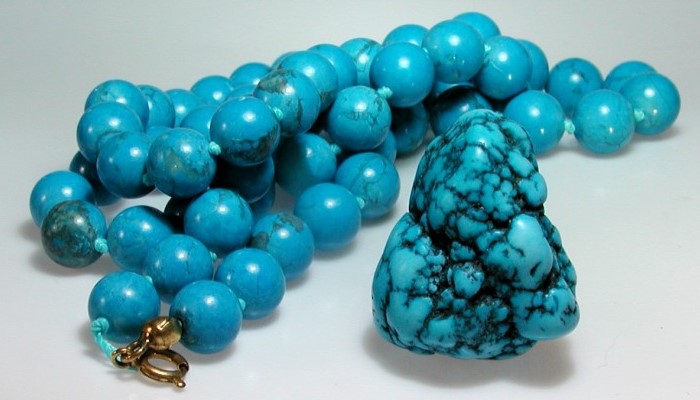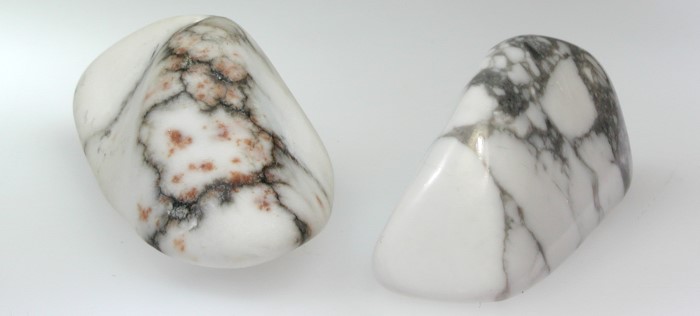The mineral howlite is not well known because of its beauty, but has a dubious reputation of being an excellent imitation for turquoise when artificially dyed. Especially in the 60s to 90s of the last century large quantities of these fake turquoises were offered. After the deposits dried up, genuine howlite has become a rarity in the gemstone sector. As a substitute material, the mineral magnesite is available, which misleadingly is declared as "howlite" or (in the colored state) as "turquoise".
Magnesite

Fig. 2: Calcium- and magnesium-carbonates are mixable in any ratio and form a continuous solid solution series.
Chart: © EPI
The magnesium carbonate magnesite [MgCO3] mostly occurs in large masses or in nodular aggregates. The most common color is white or gray (e.g. as »Pinolite« (ice flower magnesite), more rarely beige (trade name: "ivoryite") or green (trade name: "Lemon-Magnesite").
Solid solution series
Magnesite is mixable with the calcium carbonate calcite [CaCO3] in any ratio and forms a continuous solid solution serie. Calcium-magnesium carbonates with a mixing ratio of 30 - 70% Mg are called dolomite.
Howlite
There is a high risk to confuse the calcium carbonate magnesite with the calcium silicate howlite Ca2(BOOH)5SiO4. Both occur as a compact, white to beige aggregate or as porous, chalk-like rock. Just about all of the drum and gemstones offered as howlite are made of magnesite.
Howlite and magnesite can be distinguished with the carbonate test: A small sample of pulverized magnesite, which is best produced by scratching with a hard object over the surface, reacts with 10% hydrochloric acid by forming gas bubbles. Howlite on the other hand does not react.
Turquoise

Fig. 3: Magnesite dyed blue is a very widespread Turquoise Imitation.
Foto: K. Sieber, www.makrogalerie.de
The copper-containing aluminum phosphate (CuAl6[(OH)2/PO4]4 · 4H2O) Turquoise usually forms nodular or massive mineral aggregates. The always present copper content of 2 - 7% gives the mineral its light blue color. Admixtures of iron lead to greenish hues. A popular Turquoise Imitation consisting of blue colored magnesite, calcite or (in obsolete cases) howlite, is sometimes traded under the name "Turkenite". More often it is sold simply as "turquoise" or - in its untreated state - as "white turquoise".
Dyed blue, magnesite can be easily confused with turquoise. In simple cases, the artificial coloration can be detected by close inspection (Fig. 4). An uneven color distribution can be a first indication of artificial coloration.
In addition, a "carbonate test" using 10% hydrochloric acid should always be performed (see howlite) to check for the release of CO2 gas. Genuine turquoise does not react with the acid.

Fig. 4: Uneven color distribution in an artificially dyed magnesite
Foto: K. Sieber, www.makrogalerie.de
Author: Dipl.-Min. B. Bruder
© INSTITUT FÜR EDELSTEIN PRÜFUNG (EPI)
Read more on this topic:




